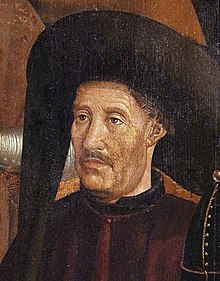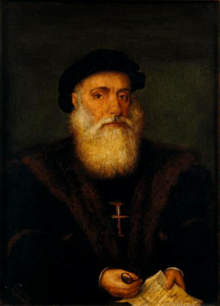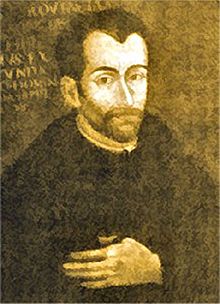Portugal

Henry the Navigator
1394–1460
Place of Birth: Porto, Kingdom of Portugal
Biography: Henry was the third surviving son of King John I and his wife Philippa, sister of King Henry IV of England. He was baptized in Porto, and may have been born there, probably when the royal couple was living in the city's old mint, now called Casa do Infante (Prince's House), or in the region nearby. Another possibility is that he was born at the Monastery of Leça do Bailio, in Leça da Palmeira, during the same residential passage of the royal couple in the city of Porto.
Henry was 21 when he, his father and brothers captured the Moorish port of Ceuta in northern Morocco, that had long been a base for Barbary pirates who raided the Portuguese coast, depopulating villages by capturing their inhabitants to be sold in the African slave market. Following this success, Henry started to explore the coast of Africa, most of which was unknown to Europeans. His objectives included finding the source of the West African gold trade and the legendary Christian kingdom of Prester John, and stopping the pirate attacks on the Portuguese coast. At that time the ships of the Mediterranean were too slow and too heavy to make these voyages. Under his direction, a new and much lighter ship was developed, the caravel, which could sail further and faster, and, above all, was highly maneuverable and could sail much nearer the wind, or into the wind. This made the caravel largely independent of the prevailing winds, and enabled her to explore the shallow waters and rivers as well as the open ocean with wide autonomy. In 1419, Henry's father appointed him governor of the province of the Algarve.
Legacy: Henry is regarded as the patron of Portuguese exploration.

Vasco da Gama
1460 - 1524
Place of Birth: Sines
Biography: Vasco da Gama was born 1460 or 1469 in Sines, on the southwest coast of Portugal, probably in a house near the church of Nossa Senhora das Salas. Sines, one of the few seaports on the Alentejo coast, consisted of little more than a cluster of whitewashed, red-tiled cottages, tenanted chiefly by fisherfolk.
Vasco da Gama's father was Estêvão da Gama, who had served in the 1460s as a knight of the household of Infante Ferdinand, Duke of Viseu and went on to rise in the ranks of the military Order of Santiago. Estêvão da Gama was appointed alcaide-mór (civil governor) of Sines in the 1460s, a post he held until 1478, and continued as a receiver of taxes and holder of the Order's commendas in the region.
Estêvão da Gama married Isabel Sodré, a daughter of João Sodré (also known as João de Resende), scion of a well-connected family of English origin.Her father and her brothers, Vicente Sodré and Brás Sodré, had links to the household of Infante Diogo, Duke of Viseuand were prominent figures in the military Order of Christ.
Vasco da Gama was the third of five sons of Estêvão da Gama and Isabel Sodré – in (probable) order of age: Paulo da Gama, João Sodré, Vasco da Gama, Pedro da Gama and Aires da Gama. Vasco also had one known sister, Teresa da Gama (who married Lopo Mendes de Vasconcelos).
Little is known of da Gama's early life. The Portuguese historian Teixeira de Aragão suggests that he studied at the inland town of Évora, which is where he may have learned mathematics and navigation. It has even been claimed (although dubiously) that he studied under the astrologer and astronomer, Abraham Zacuto.
Around 1480, da Gama followed his father (rather than the Sodrés) and joined the Order of Santiago.The master of Santiago was Prince John, who would ascend to the throne in 1481 as King John II of Portugal. John II doted on the Order, and the da Gamas' prospects rose accordingly.
In 1492, John II dispatched da Gama on a mission to the port of Setúbal and to the Algarve to seize French ships in retaliation for peacetime depredations against Portuguese shipping – a task that da Gama rapidly and effectively performed.
Legacy: Vasco da Gama is one of the most famous and celebrated explorers from the Age of Discovery. As much as anyone after Henry the Navigator, he was responsible for Portugal's success as an early colonising power. Beside the fact of the first voyage itself, it was his astute mix of politics and war on the other side of the world that placed Portugal in a prominent position in Indian Ocean trade. Following da Gama's initial voyage, the Portuguese crown realized that securing outposts on the eastern coast of Africa would prove vital to maintaining national trade routes to the Far East.

António de Andrade
1580 - 1634
Place of Birth: Oleiros, Portugal
Biography: António de Andrade was born in Oleiros, Portugal. In 1600 he went to Goa, the capital of Portuguese India, where he pursued his higher studies and was ordained a priest. He was one of the Jesuits attached to the court of the Mughal emperor Jahangir, and was head of the Jesuit mission in Agra. In 1624 he left Agra, headed to Delhi where he and the Jesuit brother Manuel Marques joined a group of Hindu pilgrims bound for the temple of Badrinath located in the Northern part of the present-day Indian state of Uttarakhand. Overcoming incredible hardships in the journey, they crossed the Mana Pass to Tibet, the first Europeans known to have done so.
Kindly received in Tibet by the sovereign of the Western Tibetan kingdom of Guge, in the capital city of Tsaparang, Andrade left after less than a month to obtain formal permission for the mission from the Father-Provincial in Goa, and to get funds and other missionaries to accompany him back to Tsaparang. Andrade returned to Tibet in 1625 and was joined by other Jesuit missionaries. They succeeded in building a church and made many converts, aided by support from the king and other members of the royal family. Andrade returned to Goa in 1629; the mission foundered soon afterward, with the invasion of Guge by Ladakh, the death of the pro-missionary king and the installation of a hostile Ladakhi-controlled government in Tsaparang. The missionaries were persecuted or expelled, the Tibetan Christians were sent to Ladakh, and by 1640 the mission, which had begun with so much promise, was over.
Andrade became the Father-Superior of the Jesuit province of Goa in 1630, leaving this post in 1633 and resuming the rectorship of the College of St. Paul. He was also active during this period as a deputy of the Goa Inquisition. He was poisoned on March 4, 1634, and lingered on in agony until March 19. The Inquisition inquiry into his death revealed that he had been murdered by disgruntled Jesuits at the College, possibly supported by powerful enemies among the Goa authorities and merchants. The matter was hushed up and nobody was ever prosecuted for the crime. Later Jesuit accounts portrayed Andrade as a martyr to the Faith who was killed because of his zeal as an official of the Inquisition.
Andrade's two extensive accounts of Tibet, written in 1624 and 1626, were published in the Portuguese original in Lisbon in 1626 followed by a Spanish translation in Segovia (Spain) in 1628 and a publication in Cracow (Poland) in the same year, and quickly translated into all the major European languages; they had a significant influence on European knowledge of and attitudes toward Tibet. Modern translations of Andrade's accounts into Italian and French are found in Toscano (1977) and Didier (2002). An English translation of Andrade's writings relating to Tibet is currently in preparation.
Legacy: Andrade was the first known European to have crossed the Himalayas and reached Tibet, establishing the first Catholic mission on Tibetan soil.

Amerigo Vespucci
1454 - 1512
Place of Birth: Florence, Italy
Biography: Amerigo Vespucci was born and raised in Florence, Italy. He was the third son of Ser Nastagio (Anastasio), a Florentine notary, and Lisabetta Mini.Amerigo Vespucci was educated by his uncle, Fra Giorgio Antonio Vespucci, a Dominican friar of the monastery of San Marco in Florence.
While his elder brothers were sent to the University of Pisa to pursue scholarly careers, Amerigo Vespucci embraced a mercantile life, and was hired as a clerk by the Florentine commercial house of Medici, headed by Lorenzo de' Medici. Vespucci acquired the favor and protection of Lorenzo di Pierfrancesco de' Medici who became the head of the business after the elder Lorenzo's death in 1492. In March 1492, the Medici dispatched the thirty-eight-year-old Vespucci and Donato Niccolini as confidential agents to look into the Medici branch office in Cádiz (Spain), whose managers and dealings were under suspicion. In April 1495, by the intrigues of Bishop Juan Rodríguez de Fonseca, the Crown of Castile broke their monopoly deal with Christopher Columbus and began handing out licenses to other navigators for the West Indies. Just around this time (1495–96), Vespucci was engaged as the executor of Giannotto Berardi, an Italian merchant who had recently died in Seville. Vespucci organized the fulfillment of Berardi's outstanding contract with the Castilian crown to provide twelve vessels for the Indies. After these were delivered, Vespucci continued as a provision contractor for Indies expeditions, and is known to have secured beef supplies for at least one (if not two) of Columbus' voyages.
Legacy: first demonstrated that Brazil and the West Indies did not represent Asia's eastern outskirts as initially conjectured from Columbus' voyages, but instead constituted an entirely separate landmass hitherto unknown to Afro-Eurasians.

Tristão Vaz Teixeira
1395–1480
Place of Birth: Kingdom of Portugal
Biography: Tristão was a nobleman of Prince Henry the Navigator's House, taking part in the conquest of Ceuta.Around 1418, while exploring the coast of Africa, he and João Gonçalves Zarco were taken off course by bad weather, and came upon an island which they called Porto Santo (Holy Harbor). Shortly after, they were ordered by Prince Henry to settle the island, together with Bartolomeu Perestrelo. Following a rabbit outbreak that made it difficult to grow crops, they moved to the nearby island of Madeira. It proved to be hospitable and cultivable, so Prince Henry sent for more settlers to colonize the island. The governance of Madeira was divided between Zarco and Tristão, who were appointed Captain-majors (capitães-donatários) of Funchal and Machico, respectively. Tristão was officially designated to the post in May 11, 1440.
Tristão Vaz took part in further raids and explorations along the coast of Africa throughout his life. He died at Silves, at and advanced age.
Legacy:the official discoverer and one of the first settlers of the archipelago of Madeira (1419–1420).
No comments:
Post a Comment